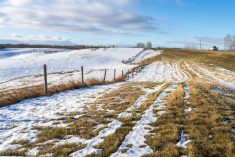Glacier FarmMedia — Seeding operations are nearing their final stages in Saskatchewan, with 72 per cent of intended acres in the ground as of May 19, according to the latest provincial crop report. That was up 23 points from the previous week and compares with the five-year average of 60 per cent done.
Producers in the southwest were the most advanced at 89 per cent complete, while the east-central region still had the most to go at 58 per cent done.
Field peas lead seeding progress by crop type at 92 per cent, followed by lentils and chickpeas at 90 per cent and 83 per cent, respectively. Large portions of many spring cereal crops have also been seeded. Triticale and durum lead cereal seeding progress was at 87 per cent, followed by spring wheat at 80 per cent and barley at 71 per cent. Canary seed and oat crops were 56 per cent and 55 per cent seeded, respectively.
Read Also

Federal budget shows remaining disconnect between agriculture, policymakers, panelists say
Canada’s agriculture sector is still disconnected from policymakers in some ways, say panelists at a CAPI webinar
Seeding progress for all oilseed crops reached the halfway point, with mustard at 84 per cent, canola at 58 per cent and flax at 50 per cent.
There was more rainfall in the province this past week compared to the week before, with the southeast corner of the province receiving the most precipitation. The rainfall helped replenish topsoil moisture in certain areas, while dry conditions in other areas continue to deplete topsoil moisture reserves.
Provincially, cropland topsoil moisture was rated as six per cent surplus, 69 per cent adequate, 22 per cent short and three per cent very short. Hayland topsoil moisture was rated as three per cent surplus, 64 per cent adequate, 27 per cent short and six per cent very short. Topsoil moisture levels in pastures were slightly drier as conditions were rated as two per cent surplus, 60 per cent adequate, 31 per cent short and seven per cent very short.
Seeding remains the primary focus for most producers in the province, but many are also busy spraying, land rolling and picking rocks. Livestock producers were also working to move their animals to the pasture for the season.















